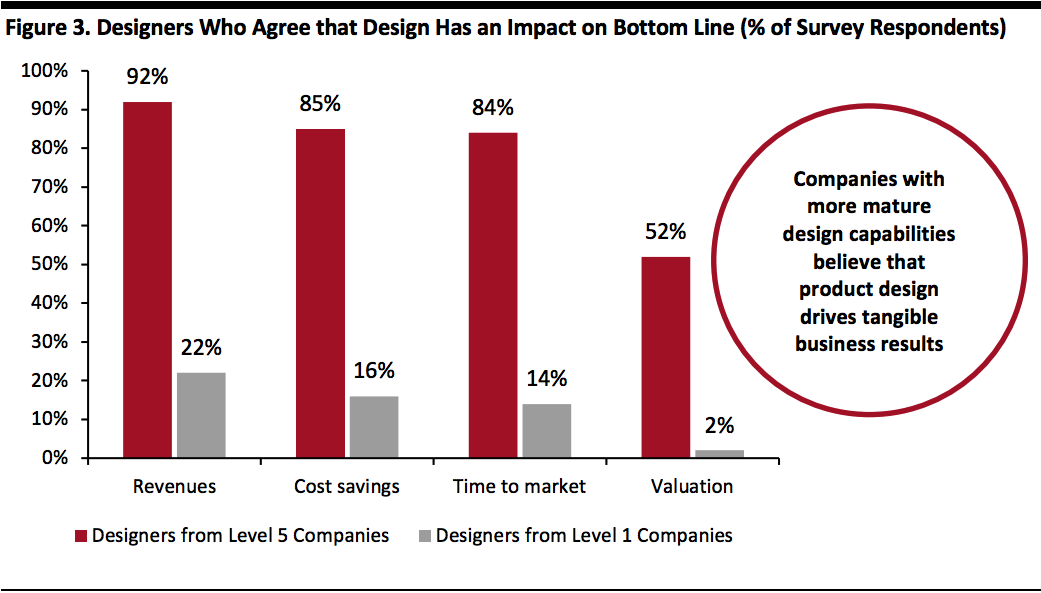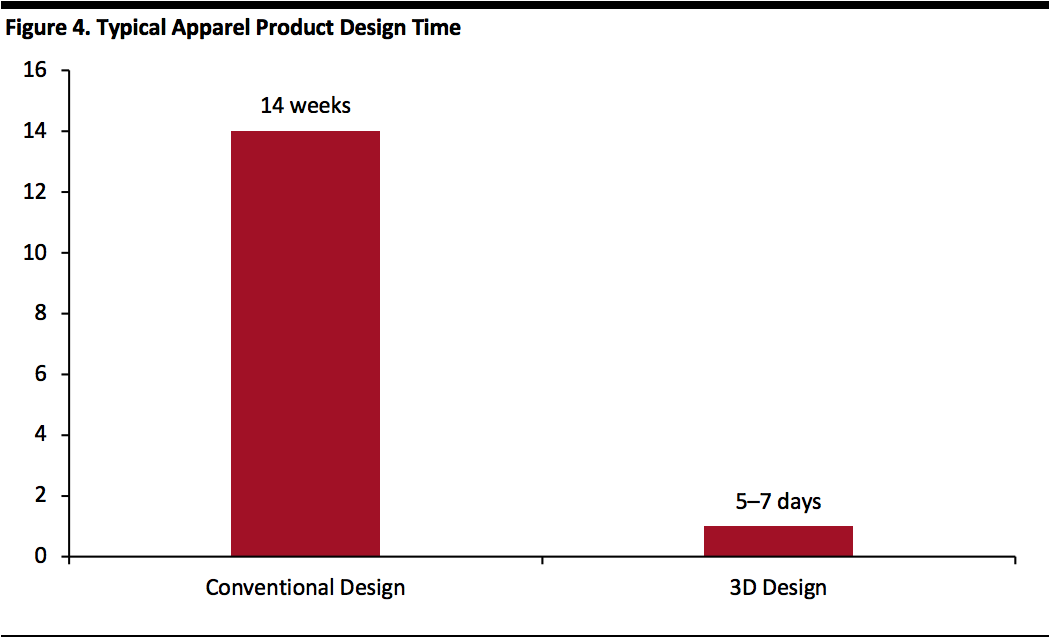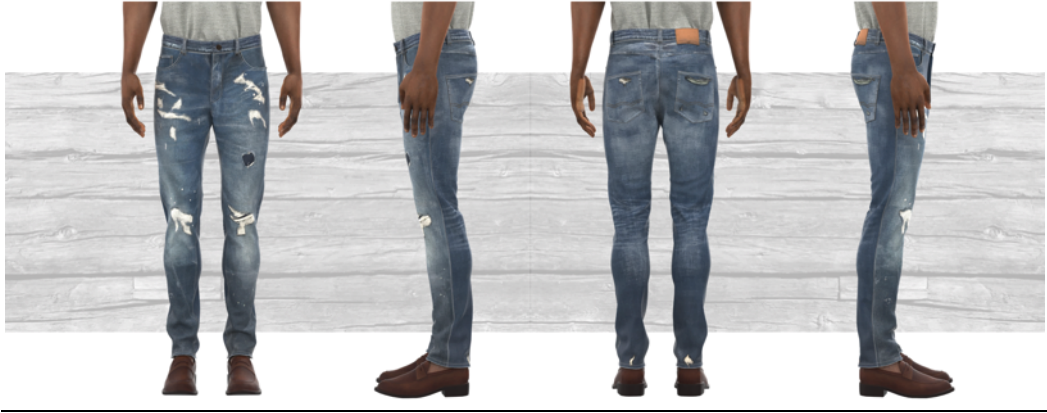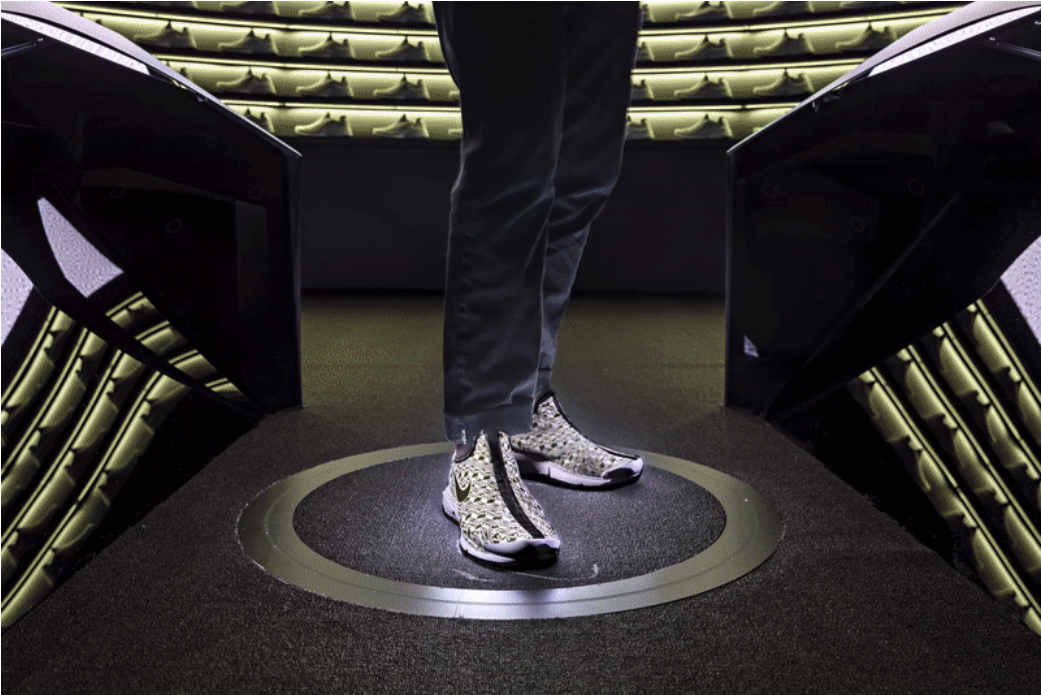
Nitheesh NH
This is the second report in the Reshaping Supply Chains for the 2020s series, in which we analyze the technologies and trends that are enabling the evolution of the supply chain.
The supply chain comprises seven major components that are integral to a retailer’s business model and can represent key sources of competitive advantage and differentiation: Companies that get their products to market faster and more efficiently than their competitors can better harness the opportunity to make a positive impact in the market. The execution of component processes is supported by various technologies throughout the supply chain—from product design to end-consumer.
[caption id="attachment_110530" align="aligncenter" width="700"] Source: Coresight Research[/caption]
The way in which companies manage their product design capability has become critical in this dynamic, fast-moving, global supply chain landscape. Product design is increasingly being recognized as an important strategic tool in brand differentiation, notably by leading brand owners such as Inditex and NIKE as well as niche brands such as Everlane. In this report, we assess the role of product design in global supply chain management and the major technologies that are introducing innovation in the design process. We also discuss case studies of relevant retailers and brands.
Source: Coresight Research[/caption]
The way in which companies manage their product design capability has become critical in this dynamic, fast-moving, global supply chain landscape. Product design is increasingly being recognized as an important strategic tool in brand differentiation, notably by leading brand owners such as Inditex and NIKE as well as niche brands such as Everlane. In this report, we assess the role of product design in global supply chain management and the major technologies that are introducing innovation in the design process. We also discuss case studies of relevant retailers and brands.
 Base: 8,000 consumers, of which 2,240 are business buyers (third-party panelists, not limited to Salesforce customers), surveyed on April 2–18, 2019
Base: 8,000 consumers, of which 2,240 are business buyers (third-party panelists, not limited to Salesforce customers), surveyed on April 2–18, 2019
Source: Salesforce[/caption] “Level 5” defines companies with mature design capabilities, for which design is a business strategy; “Level 1” defines companies with more basic design capabilities
“Level 5” defines companies with mature design capabilities, for which design is a business strategy; “Level 1” defines companies with more basic design capabilities
Base: 2,229 designers globally from 2,200 companies, surveyed in fall 2018
Source: InVision[/caption] Source: Li & Fung[/caption]
More benefits of 3D design include lower labor costs (saving 68% of costs, according to Li & Fung), reduced wastage (saving 55% of environmental waste), higher precision and streamlined communication among teams.
[caption id="attachment_110534" align="aligncenter" width="700"]
Source: Li & Fung[/caption]
More benefits of 3D design include lower labor costs (saving 68% of costs, according to Li & Fung), reduced wastage (saving 55% of environmental waste), higher precision and streamlined communication among teams.
[caption id="attachment_110534" align="aligncenter" width="700"] Li &Fung uses 3D design to allow partners to move quickly from proof of concept to testing and final design
Li &Fung uses 3D design to allow partners to move quickly from proof of concept to testing and final design
Source: Li & Fung[/caption] Apparel brand Theory uses 3D fashion design software CLO to speed up the design process and focus on the front end of a garment’s lifecycle. Theory’s emphasis on fabric and fit aligns with CLO’s lifelike representations of a material’s behavior. According to market intelligence company Reports and Data, the visualization and 3D rendering software market is expected to grow from $1 billion in 2018 to $3.7 billion by 2026. More information on significant software vendors in the market is available in our report, 3D Design Technology Disrupts the Fashion Supply Chain. Other players in the fashion industry that have been using 3D technology to achieve speed and intelligence in product design and development include Tommy Hilfiger, part of PVH Corp, and Xcel Brands, the owner of a number of fashion brands—such as C. Wonder, Halston, Highline Collective, Isaac Mizrahi and Judith Ripka. Artificial Intelligence (AI) AI can be utilized in the product design process to identify new trends and reduce the risk of forecasting errors. Designers are increasingly leveraging AI to analyze consumer data, such as purchasing behaviors and order history, to predict what new products would sell well and forecast the colors and patterns that would be popular among consumers. Stitch Fix is one retailer that employs AI in the product design process to create new apparel items. The company uses three algorithms: The first selects three pieces of clothing that could be combined to create a template for a new piece; the second algorithm suggests different attributes that have been shown to complement the chosen styles; and the third contributes an element of randomness to differentiate the product. These algorithms search through 30 trillion potential combinations of clothing attributes to offer a shortlist of nine recommendations. Human designers then use these recommendations to create a design that would appeal to consumers. [caption id="attachment_110535" align="aligncenter" width="580"] AI helps Stitch Fix sort through clothing elements to create appealing apparel
AI helps Stitch Fix sort through clothing elements to create appealing apparel
Source: Stitch Fix[/caption] Augmented Reality (AR) AR in retail powers product customization and visualization before products are produced. The Makers’ Experience by sportswear brand NIKE incorporates a NIKE By You service at select “studios” in stores worldwide. It combines AR, object tracking and projection technology (using AI and the Internet of Things) as well as digital signage to allow consumers to customize designs, virtual 3D renderings of which are overlaid onto real sneakers. Once purchased, the sneakers are produced and made available for customers to pick up within one hour. The customization service is also available online through NIKE’s e-commerce site. [caption id="attachment_110536" align="aligncenter" width="700"] Nike’s AR technology enables customers to see what customized designs look like on a pair of plain sneakers
Nike’s AR technology enables customers to see what customized designs look like on a pair of plain sneakers
Source: Nike[/caption]
 Source: Coresight Research[/caption]
The way in which companies manage their product design capability has become critical in this dynamic, fast-moving, global supply chain landscape. Product design is increasingly being recognized as an important strategic tool in brand differentiation, notably by leading brand owners such as Inditex and NIKE as well as niche brands such as Everlane. In this report, we assess the role of product design in global supply chain management and the major technologies that are introducing innovation in the design process. We also discuss case studies of relevant retailers and brands.
Source: Coresight Research[/caption]
The way in which companies manage their product design capability has become critical in this dynamic, fast-moving, global supply chain landscape. Product design is increasingly being recognized as an important strategic tool in brand differentiation, notably by leading brand owners such as Inditex and NIKE as well as niche brands such as Everlane. In this report, we assess the role of product design in global supply chain management and the major technologies that are introducing innovation in the design process. We also discuss case studies of relevant retailers and brands.
New Products Fail at a Relatively High Rate
The failure rate of new products in the retail industry is around 60–75%, according to data from analytics provider First Insight and supply chain management company Li & Fung. The rate is so high because launching new products inherently carries risk for brands: The new product may not cater to consumer preferences and there may be fierce competition from peer brands. Furthermore, bringing a new product to market takes a long time, during which a number of external factors can change that influence the likely success of the product.Retailers Should Look To Respond to Increasing Consumer Demand for Product Innovation and Immediacy
The product design process must constantly evolve to keep up with market demands. For example, consumers now want shorter lead times for new product launches: According to a survey conducted by Salesforce, 67% of consumers expect companies to provide new products and services “more frequently” than has previously been the case—up from 63% in 2018. Furthermore, creativity is becoming more critical in appealing to consumers: 68% of consumers expect the rate of innovation from companies to accelerate, and 70% of business buyers will pay more for “differentiated” products. However, immediacy remains essential, with Salesforce finding that 62% of business buyers will pay more for products that are first to market. In order to effectively respond to changing consumer demand, retailers and brands must create a more responsive, innovative and fast product design process. [caption id="attachment_110531" align="aligncenter" width="700"] Base: 8,000 consumers, of which 2,240 are business buyers (third-party panelists, not limited to Salesforce customers), surveyed on April 2–18, 2019
Base: 8,000 consumers, of which 2,240 are business buyers (third-party panelists, not limited to Salesforce customers), surveyed on April 2–18, 2019Source: Salesforce[/caption]
Design Has a Direct Impact on Bottom Line
Design impacts the bottom line for brands: Companies with more mature capabilities in design believe that these drive tangible business results, including revenue, cost savings, time to market and valuation. According to digital product design platform InVision, 92% of designers from “level 5” companies (defined as companies for which product design is more mature and comprises a business strategy) agree that design impacts revenues, while “level 1” companies (in which design is more basic) are less convinced that design has a significant business impact (as shown in Figure 3). [caption id="attachment_110532" align="aligncenter" width="700"] “Level 5” defines companies with mature design capabilities, for which design is a business strategy; “Level 1” defines companies with more basic design capabilities
“Level 5” defines companies with mature design capabilities, for which design is a business strategy; “Level 1” defines companies with more basic design capabilitiesBase: 2,229 designers globally from 2,200 companies, surveyed in fall 2018
Source: InVision[/caption]
The Ability To Leverage Technologies To Introduce Innovation Presents a Powerful Competitive Advantage
By using contemporary technologies, companies are able to become more advanced and efficient in the product design process. 3D Design A challenge for the fashion industry is that designing garments is a time-consuming process, typically taking several weeks. Designers must sometimes restart work on a design to correct miscalculations, and mailing product samples back and forth between manufacturers and brands/retailers can also cause delays. To overcome these hurdles, many companies are digitalizing their supply chains, which speeds up the process of product creation. One of the most effective ways of achieving this is to utilize 3D technology for design and sampling. 3D product design allows apparel manufacturers to visualize concepts quickly and make any number of changes before any fabric is produced. This technology also enables the creation of products on demand by cutting lead times. Only 2% of retailers are currently using 3D design, although the adoption rate is expected to reach 25% within the next three years, according to Sean Coxall, President of Supply Chain Solutions at Li & Fung. The company uses 3D product design to create digital product prototypes that can be changed instantly without having to create an array of new physical components. The benefits of 3D technology in the supply chain are most evident in the timeline of a supply chain. According to Li & Fung, it normally takes 14 weeks to undertake a conventional design process, but using 3D design can condense this into just one week. At its most efficient, the process can see samples be created within 24 hours and customer preferences identified within 48 hours; within 72 hours, retailers can find out if the consumer actually wants to order the new product [caption id="attachment_110533" align="aligncenter" width="700"] Source: Li & Fung[/caption]
More benefits of 3D design include lower labor costs (saving 68% of costs, according to Li & Fung), reduced wastage (saving 55% of environmental waste), higher precision and streamlined communication among teams.
[caption id="attachment_110534" align="aligncenter" width="700"]
Source: Li & Fung[/caption]
More benefits of 3D design include lower labor costs (saving 68% of costs, according to Li & Fung), reduced wastage (saving 55% of environmental waste), higher precision and streamlined communication among teams.
[caption id="attachment_110534" align="aligncenter" width="700"] Li &Fung uses 3D design to allow partners to move quickly from proof of concept to testing and final design
Li &Fung uses 3D design to allow partners to move quickly from proof of concept to testing and final designSource: Li & Fung[/caption] Apparel brand Theory uses 3D fashion design software CLO to speed up the design process and focus on the front end of a garment’s lifecycle. Theory’s emphasis on fabric and fit aligns with CLO’s lifelike representations of a material’s behavior. According to market intelligence company Reports and Data, the visualization and 3D rendering software market is expected to grow from $1 billion in 2018 to $3.7 billion by 2026. More information on significant software vendors in the market is available in our report, 3D Design Technology Disrupts the Fashion Supply Chain. Other players in the fashion industry that have been using 3D technology to achieve speed and intelligence in product design and development include Tommy Hilfiger, part of PVH Corp, and Xcel Brands, the owner of a number of fashion brands—such as C. Wonder, Halston, Highline Collective, Isaac Mizrahi and Judith Ripka. Artificial Intelligence (AI) AI can be utilized in the product design process to identify new trends and reduce the risk of forecasting errors. Designers are increasingly leveraging AI to analyze consumer data, such as purchasing behaviors and order history, to predict what new products would sell well and forecast the colors and patterns that would be popular among consumers. Stitch Fix is one retailer that employs AI in the product design process to create new apparel items. The company uses three algorithms: The first selects three pieces of clothing that could be combined to create a template for a new piece; the second algorithm suggests different attributes that have been shown to complement the chosen styles; and the third contributes an element of randomness to differentiate the product. These algorithms search through 30 trillion potential combinations of clothing attributes to offer a shortlist of nine recommendations. Human designers then use these recommendations to create a design that would appeal to consumers. [caption id="attachment_110535" align="aligncenter" width="580"]
 AI helps Stitch Fix sort through clothing elements to create appealing apparel
AI helps Stitch Fix sort through clothing elements to create appealing apparelSource: Stitch Fix[/caption] Augmented Reality (AR) AR in retail powers product customization and visualization before products are produced. The Makers’ Experience by sportswear brand NIKE incorporates a NIKE By You service at select “studios” in stores worldwide. It combines AR, object tracking and projection technology (using AI and the Internet of Things) as well as digital signage to allow consumers to customize designs, virtual 3D renderings of which are overlaid onto real sneakers. Once purchased, the sneakers are produced and made available for customers to pick up within one hour. The customization service is also available online through NIKE’s e-commerce site. [caption id="attachment_110536" align="aligncenter" width="700"]
 Nike’s AR technology enables customers to see what customized designs look like on a pair of plain sneakers
Nike’s AR technology enables customers to see what customized designs look like on a pair of plain sneakersSource: Nike[/caption]